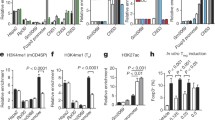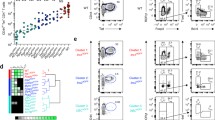Abstract
Two sets of genes control the immune response ofH-2 d mice to the synthetic antigen poly(Glu50Tyr50) (GT). One set involves class II major histocompatibility complex (Mhc) loci encoding an Ad product that serves as a recognition context to GT-reactive helper T cells (Th). The other one is a background gene, the product of which, in association with the same Mhc-restricting element, mimics the GT/Ad complex. Mice expressing the GT-mimicking background-encoded structure (Imgt), which is preferentially displayed on B lymphoblasts, do not respond to GT as a consequence of self-tolerance. On the other hand, elimination of cells bearing Imgt renders these mice responsive to GT, demonstrating that tolerance to self can impoverish the immune system. Imgt is probably not identical to GT, but resembles it in the way it forms complexes with Ad molecules ofMhc.
Similar content being viewed by others
References
Alkan, S.S.: Assay for antigen-specific T-cell proliferation in mice.In I. Lefkovits and B. Pernis (eds.):Immunological Methods 1, pp. 309–315, Academic Press, New York, 1979
Babbitt, b., Allen, P. M., Matsueda, G., Haber, E., and Unanue, E. R.: Binding of immunogeneic peptides to Ia histocompatibility molecules.Nature 317: 359–361, 1985
Benacerraf, B. and McDevitt, H. O.: Histocompatibility-linked immune response genes.Science 175: 273–279, 1972
Billingham, R. E., Brent, L., and Medawar, P. B.: Quantitative studies on tissue transplantation immunity. III. Actively acquired tolerance.Philos Trans R Soc Lond (Biol) 239: 357–414, 1956
Blomberg, B., Geckeler, W. R., and Weigert, M.: Genetics of the antibody response to dextran in mice.Science 177: 178–180, 1972
Clark, R. B. and Schevach, E. M.: Antigen presenting cells from nonresponder strain 2 guinea pigs that recognize the copolymer 1-glutamic acid-1-lysine in association with nonresponder strain 13 Ia antigens.J Exp Med 155: 635–640, 1982
Dos Reis, G. A. and Schevach, E. M.: Antigen presenting cells from nonresponder strain 2 guinea pigs are fully competent to present bovine insulin beta-chain to responder strain 13 cells.J Exp Med 157: 1289–1299, 1983
Epstein, R., Sham, G., Womack, J., Yagüe, J., Palmer, E., and Cohn, M.: The cytotoxic T cell response to the male specific histocompatibility antigen (H-Y) is controlled by two dominant immune response genes, one in theMhc, the other in theTarα-locus.J Exp Med 163: 759–773, 1986
Ishii, N., Nagy, Z. A., and Klein, J.: In vitro correlate for a clonal deletion mechanism of immune response gene-controlled nonresponsiveness.J Exp Med 157: 998–1005. 1983
Janeway, C. A. Jr.: Immune response genes, the problem of the nonresponder.J Mol Cell Immunol 1: 15–18, 1983
Kappler, J., Skidmore, B., White, J., and Marrack, P.: Antigen-inducible,H-2 restricted, interleukin-2-producing T cell hybridomas: Lack of independent antigen and H-2 recognition.J Exp Med 153: 1198–1214, 1981
Kappler, J. W., Roehm, N., and Marrack, P.: T cell tolerance by clonal elimination in the thymus.Cell 49: 273–280, 1987
Kim, K. J., Kanellopoulos-Langevin, C., Merwin, R. M., Sachs, D. H., and Asofsky, R.: Establishment and characterization of BALB/c lymphoma lines with B cell properties.J Immunol 122: 549–554, 1979
Kim, K. J., Kanellopoulos-Langevin, C., Chaouat, G., and Asofsky, R.: Differential effect of mitogens and antigen nonspecific T cell factors on the expression of surface immunoglobulins (sIg) and Ia antigens on B lymphoid cell lines.In N. Klinman, D. E. Mosier, I. Scher, and E. S. Vitetta (eds.):B Lymphocytes in the Immune Response: Functional, Developmental and Interactive Properties, pp. 507–514, Elsevier, New York, 1981
Kimoto, H., Shirasawa, T., Taniguchi, M., and Takemori, T.: B cell precursors are present in the thymus during early development.Eur J Immunol 19: 97–104, 1989
Klein, J.:Natural History of the Major Histocompatibility Complex, p. 656, Wiley-Interscience, New York, 1986
Mage, M. G., McHugh, L. L., and Rothstein, T. L.: Mouse lymphocytes with and without immunoglobulin: preparative scale separation in polystyrene tissue culture dishes coated with specifically purified anti-immunoglobulin.J Immunol Meth 15: 47–56, 1977
Matzinger, P.: A one receptor view of T-cell behaviour.Nature 292: 497–501, 1981
McKearn, J. P. and Rosenberg, N.: Mapping cell surface antigens on mouse pre-B cell lines.Eur J Immunol 15: 295–298, 1985
Pont, S., Regnier-Vigoroux, A., Naquet, P., Blanc, D., Pierrés, A., Marchetto, S., and Pierrés, M.: Analysis of the Thy-1 pathways of T cell hybridoma activation using 17 rat monoclonal antibodies reactive with distinct Thy-1 epitopes.Eur J Immunol 15: 1222–1228, 1985
Rammensee, H. G., Nagy, Z. A., and Klein, J.: Suppression of cell mediated lymphocytotoxicity against minor histocompatibility antigens mediated by Lyt1+ Lyt2+ T cells of stimulator-strain origin.Eur J Immunol 12: 930–934, 1982
Ron, Y. and Sprent, J.: T cell primingin vivo: Major role for B cells in presenting antigen to T cells in lymph nodes.J Immunol 138: 2848–2856, 1987
Schwartz, R. H.: A clonal deletion model for Ir gene control of immune response.Scand J Immunol 7: 3–10, 1978
Schwartz, R. H.: Immune response (Ir) genes of murine major histocompatibility complex.Adv Immunol 38: 31–201, 1986
Sidmann, C. L., Paige, C. J., and Schreier, M. H.: Differentiation of B cell tumors by products of monoclonal T cell immune reactions.In E. S. Vitetta (ed.).B and T Cell Tumors, pp. 413–417, Academic Press, New York, 1982
Vidović, D., Juretić, A., Nagy, Z. A., and Klein, J.: Lyt phenotypes of primary cytotoxic T cells generated across theA andE region of theH-2 complex.Eur J Immunol 11: 499–504, 1981
Vidović, D., Klein, J., and Nagy, Z. A.: Recessive T cell response to poly(Glu50Tyr50) possibly caused by self-tolerance.J Immunol 134: 3563–3568, 1985
Vidović, D. and Matzinger, P.: Unresponsiveness to a foreign antigen can be caused by self-tolerance.Nature 336: 222–225, 1988
Zamoyska, R., Waldman, H., and Matzinger, P.: Peripheral tolerance mechanisms prevent the development of autoreactive T cells in chimeras grafted with two minor incompatible thymuses.Eur J Immunol 19: 111–117, 1989
Zinkernagel, R. M., and Doherty, P. C.: Activity of sensitized thymus-derived lymphocytes in lymphocytic choriomeningitis reflects immunological surveillance against altered self components.Nature 248: 701–702, 1974
Author information
Authors and Affiliations
Rights and permissions
About this article
Cite this article
Vidović, D. Elimination of self-tolerogen turns nonresponder mice into responders. Immunogenetics 30, 194–199 (1989). https://doi.org/10.1007/BF02421206
Received:
Revised:
Issue Date:
DOI: https://doi.org/10.1007/BF02421206




